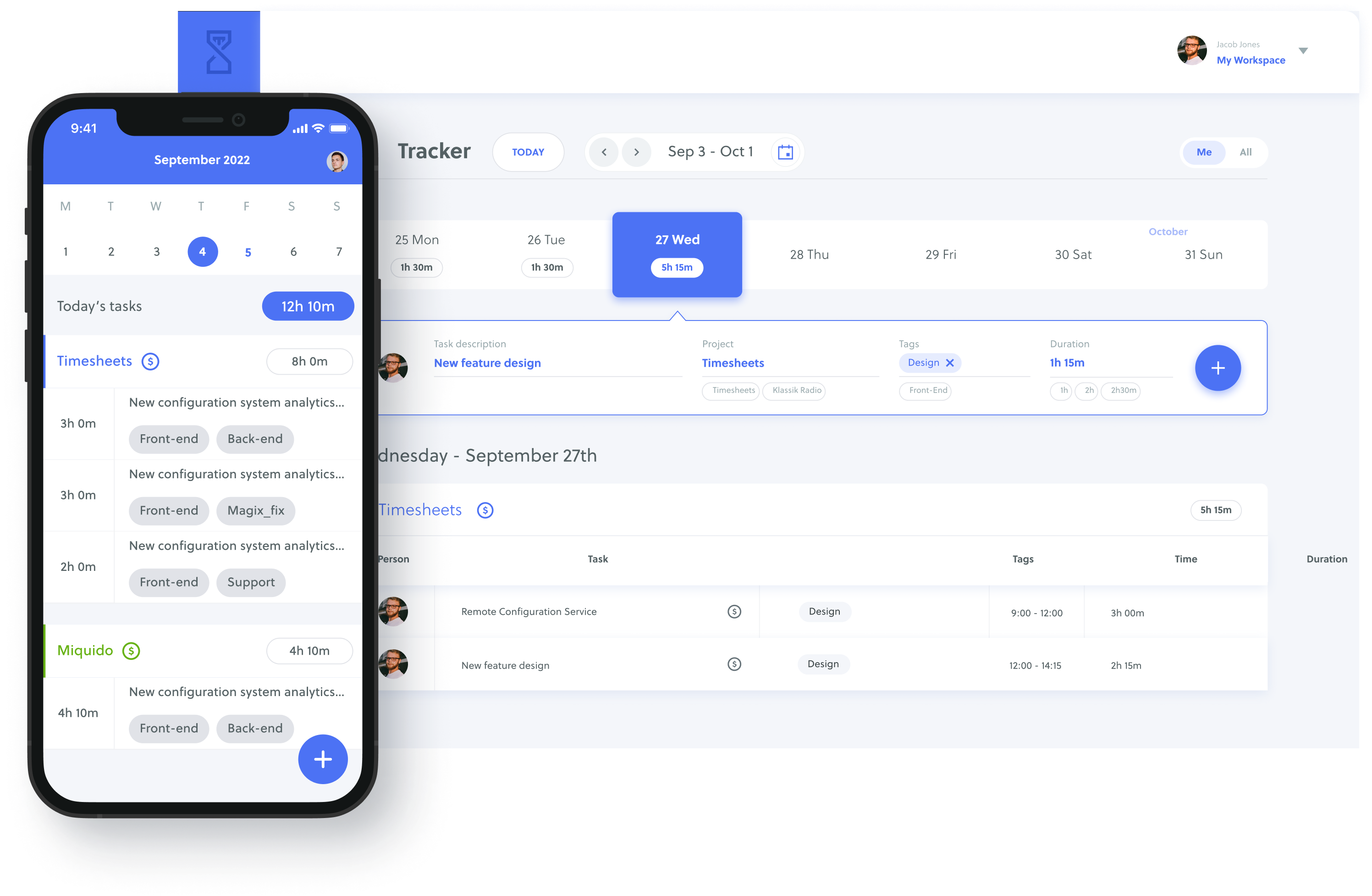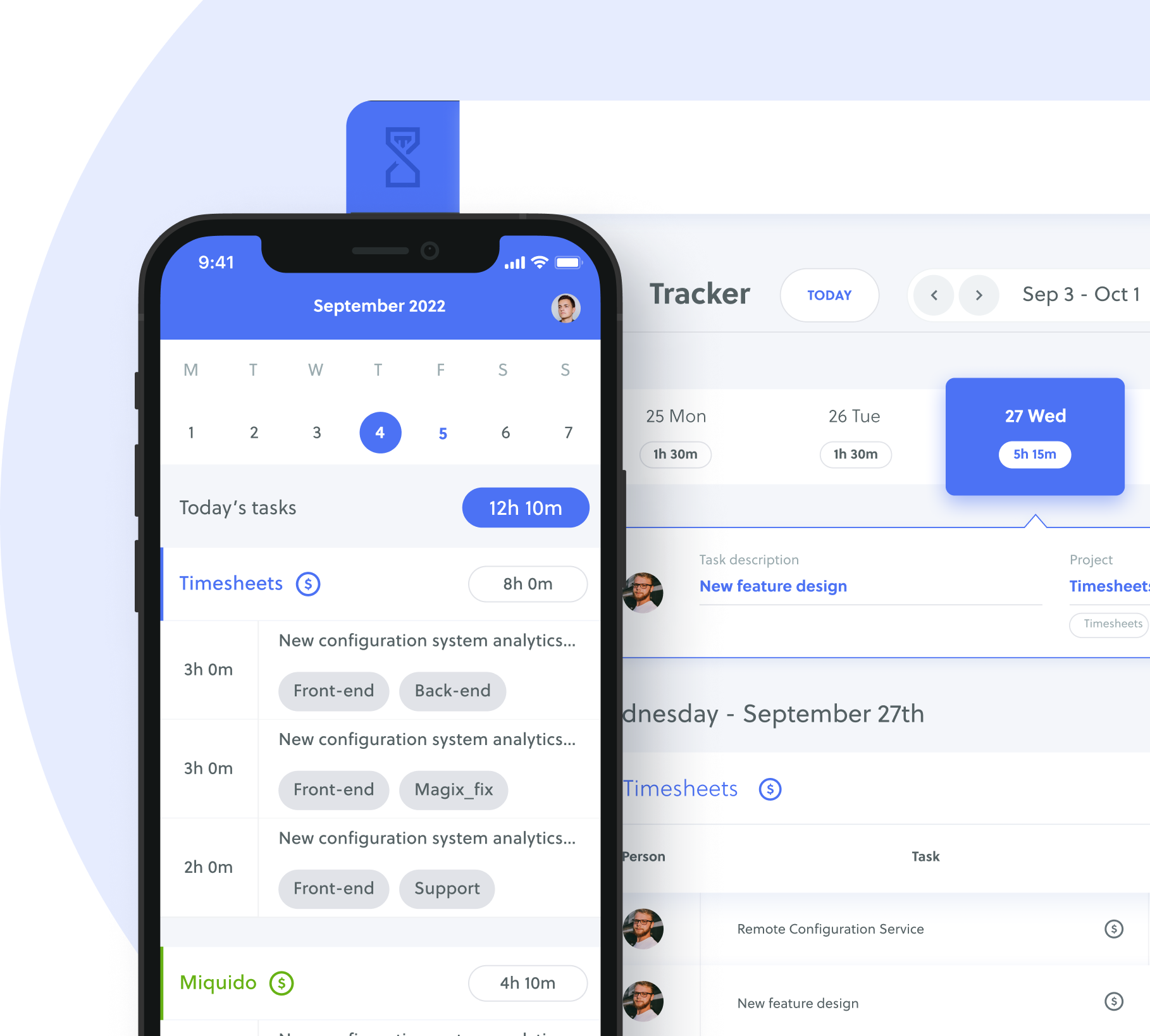Engaged employees lead to productive and efficient work, while satisfied employees lead to less turnover and more profitability.
Though many companies may know this, they often struggle with achieving high levels of employee engagement and job satisfaction. Thankfully, there are many studies and statistics out there that can help shed some light on what works (and what doesn’t).
At Quidlo, we scoured the internet and found 35 insane employee engagement and job satisfaction stats from around the world and picked apart what they mean. We hope that by understanding these numbers, you can start creating a plan to drive high employee engagement and improve your own workplace!
Ready? Let’s go.
Table of Contents
What is employee engagement and job satisfaction?
Before we dive into job satisfaction data and employee engagement statistics, let’s quickly look at what each of them means.
Employee engagement is defined as “an emotional connection an employee feels towards their work, workplace, colleagues, and company that influences their motivation to contribute to organizational success.” It’s about how involved your employees feel and how motivated they are to do their best work.
Job satisfaction, on the other hand, is “the overall satisfaction that a person feels towards his or her job. It’s based on factors like pay, benefits, career development opportunities, and recognition.
Why both employee engagement and job satisfaction are critical in the workplace
- Employee disengagement costs the U.S. Economy $450-550 billion every year. When employees are disengaged, they’re not working as hard or as efficiently as they could be, resulting in decreased productivity and revenue losses.
- A highly engaged workforce increases profitability by 21% (found in another study by Gallup). If you’re in the business of making money, then you must be in the business of creating a healthy, balanced, and productive work culture that encourages employee engagement and collaboration, which yields better company-wide results.
- There’s less turnover. Did you know that 73% of workers would consider leaving their jobs for the right offer? Employees who are engaged and satisfied with their job are more likely to stay with the company for longer periods of time, resulting in less disruption in the workplace. That means less time and money spent hiring and training new staff – especially if it’s a highly technical position that could take months.
- Attract more talent. A positive workplace helps attract top talent to your company. People are more likely to apply for jobs where they know the working conditions are favorable, and will stay in those positions when they find it fulfilling. Another underrated by-product is the positive word-of-mouth that will build a great company reputation, which can have an impact beyond just hiring.
What factors impact employee engagement & job satisfaction?
Let’s take a quick look at the biggest influencing factors (with the numbers to back it up) for what impacts how engaged and satisfied an employee is with their job.
- The work culture of your organization: Did you know that good company culture increases revenue by 4x? A positive work culture and environment that encourages career development, promotes trust and communication, and celebrates hard work is key to keeping employees engaged. A survey from the Society for Human Resource Management also found that 72% rank respectful treatment to be the most important factor to job satisfaction.
It’s also worth noting that a CNBC poll of 7,940 workers found that 18% credited their on-the-job happiness to autonomy, 15% said opportunity, and 12% said recognition. But the numbers do vary by age – take a look at the graph below:
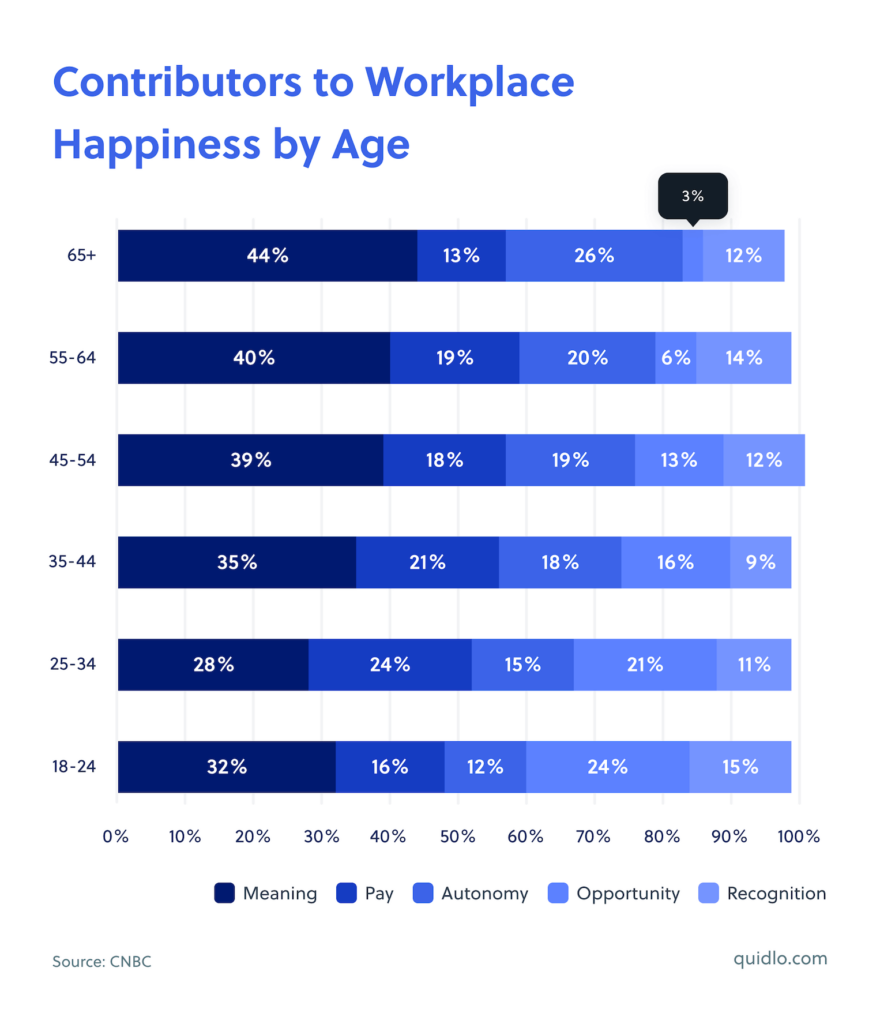
- The manager: A great manager is the glue that holds your team together and creates a positive working environment. They can help foster relationships, provide timely feedback, and create meaningful projects for employees to work on. Having strong leadership sets the tone for everyone else in the organization – for example, managers need to exhibit the behaviors and skills that encourage employees to go that extra mile.
- Salary: The money is what keeps the bills paid, family fed, and lives secure, so it’s no surprise that a competitive salary can translate to higher job satisfaction. The CNBC poll we just mentioned above also found that 20% say their salary is among the most important for on-the-job happiness. This is further backed by another finding by the Pew Research Center that revealed employees who make $75,000 per year report higher job satisfaction than those who make less than $30,000.
- The job itself: A stimulating, meaningful job is essential to keep people engaged and motivated – in fact, you’ll notice in the table mentioned earlier that 35% of employees said the meaningfulness of their job made them happy. Make sure employees are given challenging tasks with clear goals, expectations, and results – this will help them stay focused, productive, and interested in their work.
- Worker benefits: You want to make sure you have competitive incentives that set you apart from other employers in the same industry. In Metlife’s 20th annual U.S. employee benefit trends study, 79% of employees say health insurance and a 401k (or other retirement plan) are must-haves. And regarding non-insurance benefits, 40% say paid time off is at the top, followed by flexible/remote working options (30%), and fitness/healthy lifestyle incentives (17%).
- Interestingly, some benefits are more important than others based on gender. For example, women (44%) are more likely than men (39%) to leave their current job for a new one with a flexible work environment. However, men (40%) are more likely to leave their current job for a higher position in a different company than women (30%), suggesting that better-ranking positions tend to motivate them more than flexibility – and vice-versa for women.
Only 34% of employees are engaged in the workplace.
When Gallup asked a random sample of 14,705 U.S. full and part-time employees about specific workplace elements that link to many organizational outcomes (e.g., profitability, productivity, customer service, retention, safety, and overall well-being), they found something astonishing.
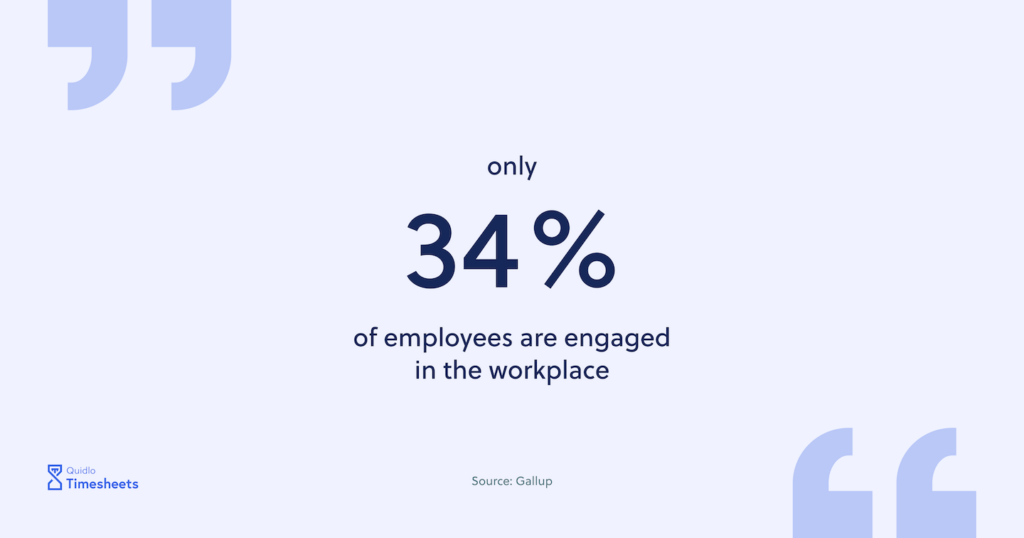
The U.S. saw its first annual decline in a decade when it comes to employee engagement, dropping from 36% (2020) to 34% engaged employees in 2021 and early 2022, while 17% are actively disengaged employees (miserable at work, disloyal, moody).
Some of the “workplace elements” talked about were
- employees’ level of agreement about clarity of expectations
- opportunities for development
- weight of their opinions at work
- recognition
- relationship with their manager
This goes to show that it’s not just about offering attractive salaries and benefits, but also about creating an environment where people feel seen, supported, and appreciated. Especially during these difficult times, organizations need to focus on ways to keep their employees engaged – whether through development opportunities or by investing in technology to help them stay connected with their colleagues.
86% of both employees and executives cite a lack of collaboration and ineffective communication as the main reason for workplace failures.
(Source: Fierce, Inc)
It’s a team effort when it comes to figuring out why workplace failures happen. Most workers think more communication and collaboration would make a difference, but only 18% of performance reviews evaluate communication as criteria.
Employers can start by setting clear expectations and providing support to ensure employees have the resources needed for successful communication. For example, if you’re a remote team, you could invest in a task management and time-tracking tool like Quidlo to make team collaboration a money-making breeze. Just add everyone’s work email addresses to the workspace, create your projects, add necessary tasks to the projects, and assign the appropriate roles.
This way, everyone’s on the same page and knows exactly what needs to be done.
👉 Related: 5 Tips on How to Introduce Time Tracking Solution to Your Team
Additionally, companies can look into team-building activities or innovative ways to facilitate collaboration among teams (e.g., virtual happy hours or weekly challenges).
Investing in these initiatives can save organizations time and money, prevent costly mistakes, and improve employee morale.
A 10% increase in a company’s engagement can boost profits by $2,400 per employee every year.
If you can get your employees to care just 10% more about what they do, you can bring in $2,400 per employee a year.
Zippia (formerly Recruit Loop) shows how boosting worker engagement can pay off financially for employers. You can boost profits by raising staff morale, which leads to increased productivity and improved customer service.
91% of highly engaged employees report being satisfied with their professional development opportunities.
According to Bonusly, 91% of highly engaged employees report feeling genuinely satisfied with their professional development opportunities.
This is key to providing a well-rounded work experience that can help extend employee retention rates and boost morale. There are several ways to promote professional growth, such as providing adequate training, feedback, recognition of hard work, and offering career advancement opportunities.
38% of Remote Employees Feel Exhausted After Daily Virtual Meetings
Research from a Doodle survey has revealed that 38% of remote employees feel exhausted after attending daily virtual meetings.
This is mainly due to the lack of physical interaction, which can lead to feelings of isolation and burnout. On top of that, it’s worth noting that 93% of communication is non-verbal, meaning that our body language and tonality have a lot to do with comprehension. This huge chunk of communication is lost when we’re limited to online platforms.
To ensure that your team stays productive and engaged, see if you can move away from the daily meetings and have weekly ones instead. And for the meetings that do happen, don’t just dive right into work-related matters.
Start off with more casual conversations, such as catching up on how everyone is feeling and what’s new in their lives. Play a game. Run a poll. Doing so will help break the ice, promote social interaction, and keep employees engaged during meetings.
85% of employees are most motivated when internal communications are effective.
Effective internal communication motivates 85% of employees to be more engaged, says Trade Press Services.
Regularly discussing company news, relevant information, and weekly targets motivate employees to achieve their mission, vision, and goals. By making them aware of your goals, they’ll be more engaged with your customers. Again, Quidlo is one such tool that allows employees to see all their monthly projects, weekly tasks, and total time spent on them on one platform.
👉 Related: 9 Benefits of Time Tracking
Other ways to take advantage of internal communications are employee newsletters, press releases, event updates, and milestones, and sharing success stories. Build a learning-focused community by sharing info regularly to increase knowledge, improve internal communication, and empower teams to collaborate.
37% of Employees Consider Recognition the Most Important
O.C. Tanner’s survey showed that 37% of employees say recognition to be the most important for their job satisfaction – specifically in the forms of affirmation, feedback, and reward.
Acknowledging and recognizing your team’s hard work is a great way to keep them motivated, engaged, and satisfied with their jobs. In fact, 46% of US workers leave their jobs because of a lack of appreciation. From saying “thank you” more often to rewarding staff with bonuses and gifts, it has been proven that displays of genuine appreciation encourage employees to “produce better work more often.”
Furthermore, Great Place to Work analyzed 1.7 million employee survey responses gathered between 2018 and 2020 in small, mid-sized, and larger companies. The study found that recognition was strongly associated with several aspects of positive company culture when compared with employees who don’t receive recognition.
Those who received proper recognition were:
- 2.6x more likely to think that promotions are fair
- 2.2x more likely to say innovative thinking is embraced
- 2.0x more likely to say people here are willing to go above and beyond
Employee-recognition programs funded with at least 1% of payroll are more likely to be rated successfully by HR managers than underfunded programs or programs with zero budget.
Employee recognition initiatives with an underfunded budget or no budget at all fail to deliver the expected results. These programs need a certain amount of money – usually at least 1% of payroll, Workhuman has revealed.
This is because recognition initiatives need constant budgeting to be successful, as well as effective communication and training for managers. This will provide them with the necessary skills to know how and when to give recognition, which helps make sure that everyone’s efforts are appreciated.
96% of employees believe showing empathy is an important way to advance employee retention
According to Forbes, 96% of employees believe that showing empathy is an important way to advance employee retention.
This goes a long way in providing a positive work environment – one where employees feel valued and respected. Empathy also helps build trust between colleagues and management, as it shows that you are mindful of their feelings and want them to succeed.
You can show empathy in a range of ways, such as sending encouraging messages to your team during difficult times or offering flexible working hours when needed. Even simply listening to your employees’ problems and concerns is a great way to demonstrate understanding.
The bottom line is that demonstrating empathy will help create strong relationships between management and employees, which in turn leads to higher job satisfaction.
1/3 of people who make less than $25,000 have a job satisfaction rate below 50%
Low-income workers are more likely to experience job dissatisfaction, according to Zippia’s study. Specifically, it’s people who make less than $25,000 per year who tend to have lower job satisfaction rates, with over 1/3 of jobs in this category having below 50% job satisfaction. This is likely due to the fact that many low-wage positions offer limited benefits and limited job security.
Here’s a list of the specific jobs:
- Fast-food workers
- Cashiers
- Operators of photographic processing machines
- Short-order cooks
- Parking lot attendants
- Dishwashers
- Cafeteria waiters
- Dry cleaners
37% of employees cite low salaries as one of the major reasons behind quitting.
37% of employees who quit their jobs in 2021 said low salaries were one of their major reasons, while 26% said it was a minor one. According to the same job satisfaction statistics, 33% quit because of no advancement opportunities, while 35% quit because of disrespect.
The Pew Research Center’s study found that employees with higher salaries are more likely to stay in their job longer, making it important for employers to offer competitive wages if they want to keep their teams happy.
One way of doing this is by finding out what the market rate is for certain positions, and then offering a rate that is 5-10% higher than the market rate. Additionally, employers should also review their salaries at least once a year to stay competitive in their industry and make sure that employees are being fairly compensated for their work.
30% of American workers say their job is “just a job to get them by.”
According to the Pew Research Center, nearly a third of American workers say their job is “just a job to get them by.” That’s a huge chunk of the workforce who feel unfulfilled and unmotivated in their current roles.
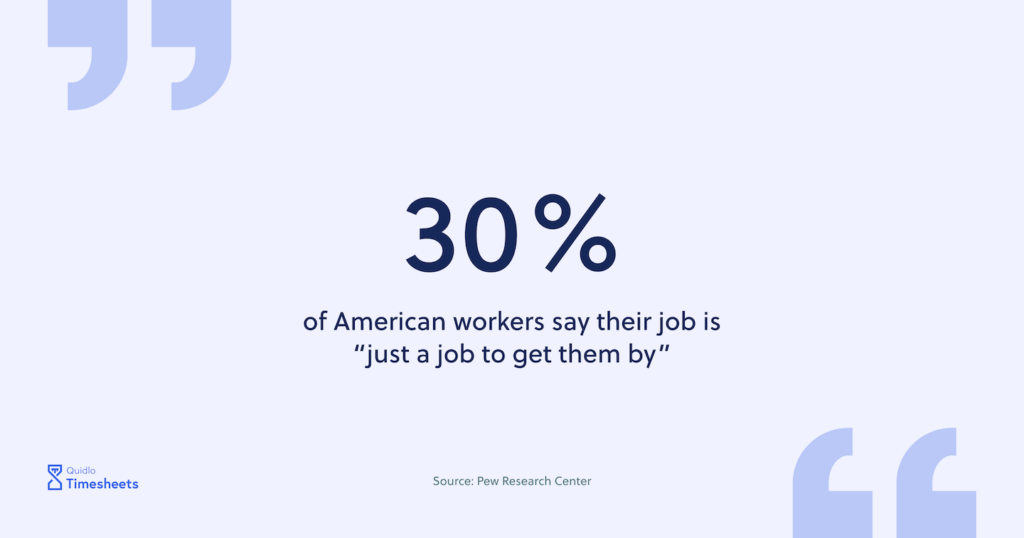
The idea is not just to find work that pays well but also work that provides a sense of purpose and meaning. The best way to do that is by listening to your employees and understanding their interests, strengths, and weaknesses. That way, you can help them find ways to stay passionate about their jobs without sacrificing job security or benefits.
Any job that pays over $75,000 per year has an average job satisfaction rate of 59%.
Among those with a family income of $75,000 or more, about six-in-ten (59%) are very satisfied with their job, compared with 45% of those making $30,000 to $74,999 and 39% of those making less than $30,000.
However, it is more common for certain types of employees to say they’re more satisfied than others. For instance, management employees are more likely to say they’re very satisfied (62%), compared to people who do manual work (48%). Your office tenure also matters. Because more than half of full-time employees (52%), salaried workers (58%), and permanent workers (53%) say they’re happier with their jobs, compared to those with temporary positions.
These statistics show that employers should be cognizant of their staff’s salaries, the types of long-term positions they have available, and the ways in which employees can advance within a company. By doing this, employers can ensure that their staff members feel appreciated and valued, which will ultimately lead to higher rates of employee engagement and job satisfaction.
Organizational culture impacts job satisfaction by 42%.
An on-the-ground study performed on 64 employees at the PT Telkom Makassar Regional Office showed that organizational culture has a considerable impact on job satisfaction. The study found that 42% of employee job satisfaction was correlated to the organizational culture, while the remaining 58% was attributed to other variables.
The study highlighted some main elements of a strong organizational culture. You can see them below:
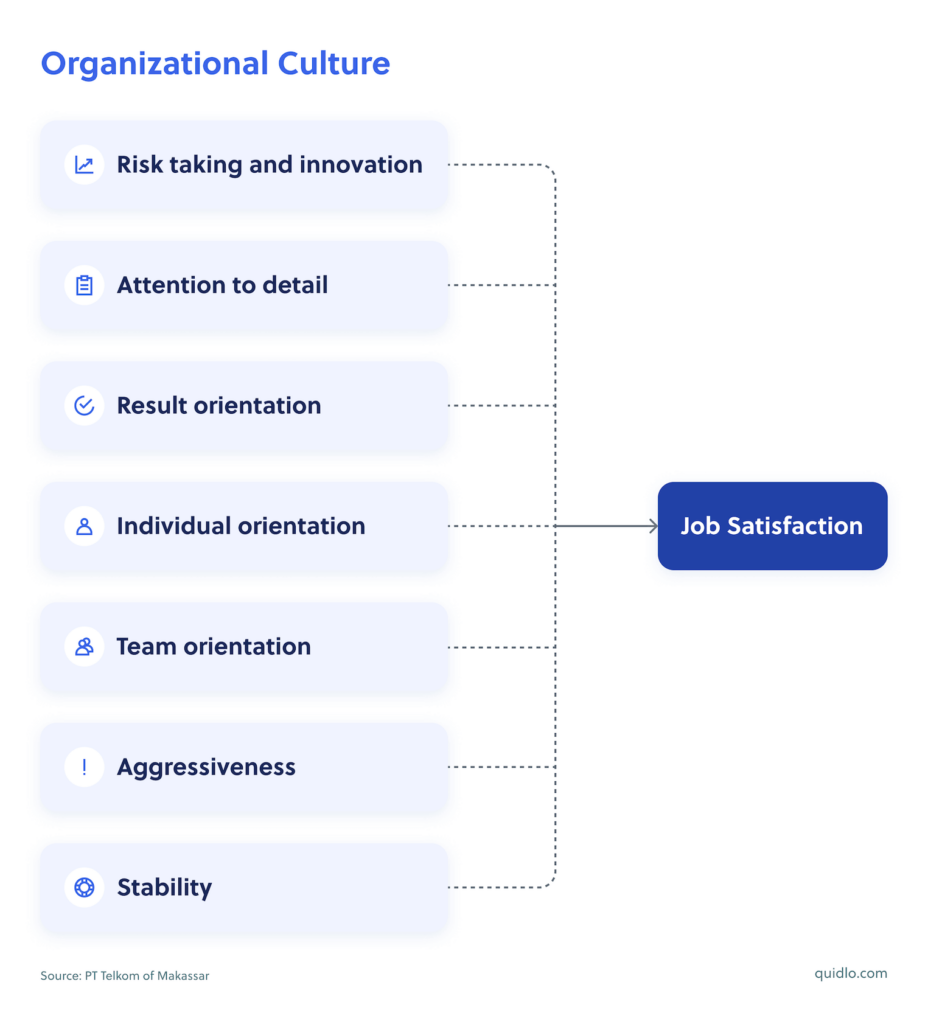
Remote workers report being the happiest in their jobs
While many companies (especially in tech) are trying hard to get their workers back in the office, data from CNBC suggests that employees who work fully or mostly from home are happier than those who work in an office.
Specifically, over half (52%) of fully remote workers are very satisfied, compared to 47% of workers who mostly work from home, 40% of workers who mostly work at the office, and 47% of workers who fully work from the office.
There are quite a few reasons for this, some of which are unsurprising:
- No need for long and tiring work commutes
- People have gotten used to their home office
- More time with family
Those who work fully remote say they’re happier with their pay, have more recognition from colleagues, have more opportunities for advancement, and have a lot more control over their work. On just one measure, in-person workers score higher: 68% view their jobs as very meaningful, compared to 60% for remote workers and 54% for mostly in-person workers.
The table below provides more insights:
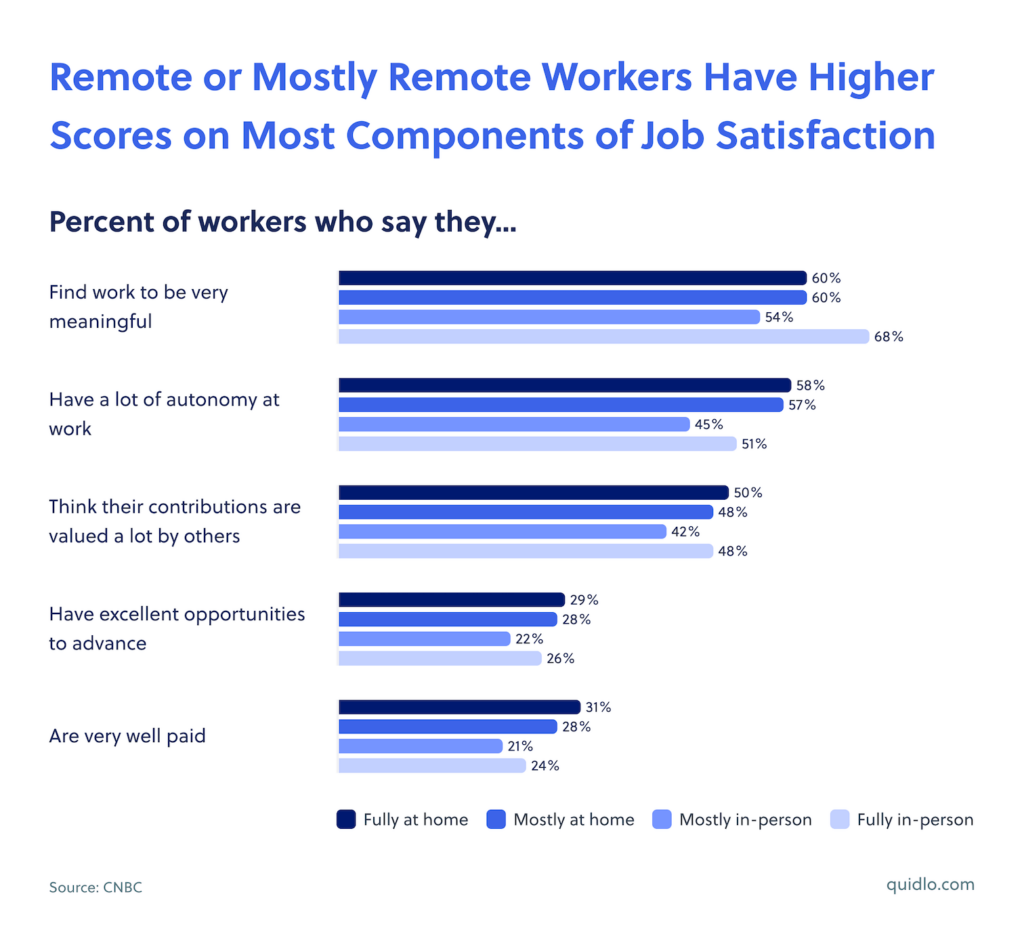
Job satisfaction increases by nearly 20% over time
As you get older, job satisfaction increases, as only 26% of respondents between 18-29 consider their current job a career, compared to 60% between 30-49.
From 18-34, you have a job satisfaction rate of 31%, which rises to 42% from 30-49. When you’re 50-64, job satisfaction peaks at 49%. This is an increase of nearly 20% from when you started your career.
These findings by Zippia suggest that job satisfaction increases with age and experience, indicating that employers should provide more opportunities for growth and development to retain older employees who are more likely to feel satisfied in their current positions.
The lower rates for young people could be due to a lack of job experience, difficulties finding jobs that fit their qualifications, or simply feeling overwhelmed by starting a new career. So employers may want to consider offering more support and guidance to younger employees, like a more welcoming onboarding process, regular follow-ups, and team-building initiatives.
A great onboarding experience can lock down 69% of employees for at least three years.
An employer’s first chance to shape an engaged worker is onboarding. The most important ways to retain staff are to communicate the company mission, establish clear goals, and provide adequate training and mentoring. Because keeping employees engaged starts on day one.
When properly implemented, data from the Society for Human Resource Management (SHRM) shows that an effective onboarding process can lock in 69% of new hires for at least three years. As you can see, there’s a clear correlation between well-structured onboarding and long-term retention.
The implications this has on employee engagement are significant. A well-built onboarding process can foster a sense of purpose and belonging that leads to higher levels of commitment and job satisfaction. This is especially true for younger employees who may not be used to the working world yet, but are more likely to stay if they feel supported and connected.
60% of employees consider coworkers to be the biggest contributors to job happiness.
In Statista’s poll on job satisfaction from 2019, 60% of respondents said commuting to work and people at work contributed to their job satisfaction.
Aside from that, 59.9% said that interest in work was important. Also important to them were the physical environment (59.3%), job security (59.2%), and supervisor (55.4%).
This data suggests that coworkers and the people we work with have a major impact on job satisfaction. Having positive relationships and interactions between coworkers has been shown to increase work productivity, encourage collaboration, and improve overall morale in the workplace.
It’s important for employers to create an environment where employees feel comfortable with each other and can develop strong relationships. This can be done through regular team-building activities, beneficial rewards and recognition programs, or even just creating a space to have lunch together and get to know each other better.
Organizations with high employee satisfaction outperform low employee satisfaction companies by 202%.
The link between employee satisfaction and company performance is clear. According to a survey conducted by Business2Community, organizations with higher levels of employee satisfaction have an average of 202% higher net income than those with lower levels of employee satisfaction.
This makes sense—happy employees are productive employees and motivated to work above and beyond for the success of the organization. This highlights the importance of establishing strategies that prioritize employee satisfaction in order to maximize business results. Companies should consider implementing flexible scheduling, offering professional development opportunities, providing feedback and recognition, and establishing meaningful communication channels.
Additionally, a Gallup study found that in high-engagement business units, there was also lower absenteeism and turnover – problems particularly common in the manufacturing industry. In 2016, one of their reports found that 70% fewer safety incidents were reported by companies with higher engagement levels. These findings demonstrate that employee engagement is essential to a successful, safe, and productive business.
33% of employees state that their reason for leaving their job is boredom
A survey conducted by Korn Ferry revealed that more than one-third of employees leave their jobs because they are bored. Whether we’re talking about the mailroom to middle management, about half of workers take their foot off the gas for at least ten hours a week – sometimes even more, all because they’re uninspired.
It’s also interesting to note that Millennials’ tolerance levels (the point when they mentally check out and plot their exit) are much lower than the Baby Boomer generations.
And the reason isn’t that people don’t have enough to do. Rather, it’s because their work has no meaning (or at least, that’s what it seems like), and when human beings are faced with meaninglessness, they create distance or resist. A bored employee has no motivation to focus on the work, and every reason to check out social media and job postings during work hours.
You’re especially at risk of staff boredom if you’ve made assumptions or established policies that apply to thinking that’s now 10 years old, when Millennials mostly started taking over for Boomers. So it’d be wise to rethink your company protocols and customs around how you reward, retain, and inspire employees.
Employers can also help combat workplace boredom by discussing employee goals, giving them ownership of projects, or offering more challenging assignments.
Only 13% of Americans are very passionate about their jobs.
A survey conducted by Deloitte found that only 13% of employees in the United States report being “passionate” about their current job, a striking statistic from an employee engagement perspective.
The study explains that passionate workers generally exhibit three characteristics:
- A long-term commitment to making an impact
- A curious interest that actively seeks out new challenges in order to improve faster
- And an inclination to build trust-based relationships with others who can provide assistance
The respondents fell into three clusters:
- Passionate Employee – 13% of respondents possess all three attributes of worker passion.
- Contented Employee – 23% of respondents scored high on an index of engagement indicators, but not all three attributes.
- Half-hearted Employee – 64 percent of respondents score low on engagement and don’t have all three attributes of worker passion.
To inspire more passionate employees, business leaders themselves should demonstrate more enthusiasm for taking on difficult challenges and pushing boundaries in potentially exciting directions, so employees follow suit. And while it may not seem like it at first, investing in automation can also make employees more engaged and passionate, since it has the potential to eliminate daily repetitive and tedious tasks that may be draining their enthusiasm.
52% of the US workers said they experienced job burnout in 2021.
It was found in a March 2021 Indeed report that 52% of workers were burned-out, while 67% said that feeling grew worse during the pandemic. As the work-life line blurs in an online workplace, workers spend longer hours at work, making it more difficult to unplug.
Of 1,500 people surveyed by Indeed, 36% said more paid time off (PTO) would help them cope with burnout – and if no changes are made at their workplace, employees are likely to leave.
Some things you can do to help reduce burnout and keep employees engaged with their work are:
- Hybrid work options – One in three Americans do not want to return to work full-time. Employees get the best of both worlds with a hybrid model. You can keep your staff in the office when needed, while giving them a break from work two or three days a week.
- Robust technology – To reduce burnout, it’s critical that your technology is up-to-date. Deploy automation tools to streamline tedious tasks and make communication easier with cloud-based messaging services.
- Invest in mental health – Support your staff’s mental health with activities and programs that promote resilience, such as yoga, meditation classes, and stress-reducing workshops.
Employees who feel their superiors treat them with respect are 63% more satisfied with their jobs.
Respectful cues in a professional setting are important signals of social worth, as people’s jobs often shape their identities. So it’s difficult to stay motivated, engaged, and satisfied with your position in a company that doesn’t recognize your worth.
A Harvard Business Review study found that employees who feel their superiors treat them with respect are 63% more satisfied with their jobs. The same study also found that when workers experience a lack of respect, they become significantly less productive and more likely to leave the company sooner than those who report feeling respected by their superiors.
There are two kinds of respect:
- Owed respect: This is the basic respect that everyone in an organization should get for the work they do, regardless of title or position (e.g., respecting opinions, showing up on time, and meeting deadlines).
- Earned respect: This is based on demonstrated competence and professionalism. It’s something you earn from your peers and superiors through exemplary performance. And often expressed through recognition, rewards, and promotions.
To create an atmosphere of respect, you need to find the right balance between these two.
When there’s a lot of owed respect but little earned respect, people tend not to focus on their individual achievements because they think everyone will be treated the same. In settings where goals need to be achieved as a team, that might be the right mix, but it risks reducing motivation and accountability. On the other hand, employees with high earned respect but low owed respect can end up competing excessively, which is unhealthy and toxic.
Only 16% of companies use technology to monitor employee engagement.
Only 16% of companies use technology to track employee progress and engagement, according to a Gartner poll. To monitor employee activity, they track when employees clock in and out, how many hours they work, and when they take breaks.
Keeping track of your team’s performance is essential to a strong employee engagement strategy, especially if you’re a remote workforce. Quidlo doesn’t just streamline your team’s communications, it provides upper management a clear insight into their employees’ workloads and performance.
With its activity tracking feature, you can monitor each individual’s progress in real-time. You can also see who is working on a task, when it was completed, and how many hours were spent on it.
By having the right data at your fingertips, managers can keep their teams motivated and engaged by providing feedback, setting realistic performance goals, and recognizing the team’s hard work.
72% of surveyed professionals say having more work benefits would increase their job satisfaction.
According to a Zoro survey, 72% say having more work benefits would increase their job
satisfaction. From health insurance and remote working options to tuition reimbursement and professional development opportunities, there are plenty of benefit packages employers can provide to their employees.
These perks not only help attract the best talent and retain employees, they also make people feel valued. That’s why it’s important to invest in the right benefits that will give your staff the freedom, flexibility, and resources they need to perform at their best.
Parting Words
When it comes to employee engagement and job satisfaction, there’s no one-size-fits-all approach. Companies must tailor their strategies and benefits packages to their unique work culture in order to create an environment that encourages employees to stay motivated, engaged, and satisfied with their position. With the right mix of owed respect and earned respect, along with the right benefits package, companies can ensure their employees feel valued and appreciated.
Quidlo is here to help! Our employee time tracking software allows you to track the time your staff spends on tasks so that you can get a better understanding of their performance and productivity levels. It’s easy to keep tabs on your employees’ hours and ensure they’re getting the respect and recognition they deserve.






